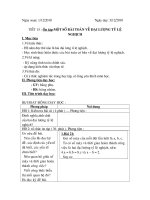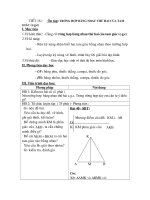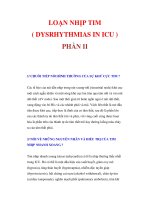7 examination in icu
Bạn đang xem bản rút gọn của tài liệu. Xem và tải ngay bản đầy đủ của tài liệu tại đây (11.53 MB, 731 trang )
Carole Foot
Liz Steel
Kim Vidhani
Bruce Lister
Matthew Mac Partlin
Nikki Blackwell
Introduction to the DVD content
In this edition of Examination Intensive Care Medicine we have created a DVD that complements the book. The
reason for this is two fold. Firstly, with the growth of intensive care as a specialty and our desire to add to the content
of the intensive care medicine component of the 2006 Examination Intensive Care and Anaesthesia publication, there
was need for greater storage capacity, without necessitating the release of multiple volumes. Secondly, the format
allows us to engage on a more interactive, portable and user friendly level. The topics represent the core areas that
1
routinely appear in Critical Care specialist examinations and as much as possible, are in line with CoBaTRICE , the
2
3
4
UK DICM , European EDIC and the Australian and New Zealand CICM guidelines and objectives of training.
The content of the DVD is fully indexed and navigable by clicking on the section or topic of interest. It is divided into
the following five sections.
Chapter supplements
Recall cases
Pharmacology quiz
Case scenario flow diagrams
Useful resources
The first section continues with material that supplements chapters 4 to 6, 9 and 10. It contains a more extensive
catalogue of commonly encountered ICU data, equipment, procedures and literature. A pharmacology section is
provided in quiz format.
The second section concentrates on active data interpretation, as encountered in the written and viva components of
the FCICM, EDIC and DICM examinations. Common patterns and how to extract them are highlighted, with answers
and explanations provided. The specific abnormalities that are used to draw the appropriate conclusions are explicitly
indicated. It is thereby hoped to assist candidates to develop the ability to think critically, rapidly identify useful
patterns and practice the application of what has been learned. In doing so, you should also be better able to adapt to
and deal effectively with situations which you may not have specifically studied or encountered before.
Additionally, specific effort has been made to use the language of the exam in both the questions and the answers, in
order to familiarise candidates with it and to encourage the use of focussed, efficient answers.
The individual topics covered in this recall case section can be accessed by sub-section or, for a bit more of a
challenge, in completely random order. They are also fully indexed, in case you want to revise a specific issue. It is
recognised that most hospital laboratories will have their own reference ranges for various assays and that a smililar
situation exists for some monitors. It is also recognised that Australian measurement units may differ from European
units; e.g.mmHg versus kPa. So, a set of common reference ranges has been supplied for use during the Recall
Cases. It is also recommended that you try to memorise the frequently recurring ranges, even though they are often
provided in the exam, as this speeds up your data processing and can create a bit of extra time for time-hungry
questions.
Both adult and paediatric data are presented.The key areas presented in this section are:
o
1. Laboratory
Biochemistry
Haematology
Microbiology
o
o
o
Endocrinology
2. Imaging
Plain films
Computed tomography (CT)
Magnetic resonance imaging (MRI)
ECHO cardiography
Other modalities (e.g. FAST)
3. Electrocardiographs (ECGs)
4. Monitoring data
Non-invasive (e.g. SpO2, EtCO2)
Invasive (e.g. PAC, PiCCO, FloTrac, CVP, ICP)
Ventilator waveforms and capnography
Transcranial doppler (TCD)
Electroencephalographs (EEGs) and Bispectral index (BiS) monitors
SSEPs and nerve conduction studies
5. Clinical examination patterns and spot diagnoses
In order to make the rote learning of pharmacology facts more engaging, we have created a Pharmacology quiz for
the most commonly used agents in intensive care medicine, wherein you try to work out what drug is from a series of
clues.
The DVD also contains a set of scenario diagrams. These are intended to assist you with preparing for and
rehearsing your approach to the clinical cases that you will encounter in your exam, such as those that are presented
in Chapter 8 - Clinical cases. Each of the diagrams can be printed out as often as you need and can be used to write
your own notes as you structure your strategy for tackling these and other cases. You can also leave them blank and
use them to test yourself and your colleagues; particularly if you have difficulty in getting access to some of these
patient types.
Blank scenario sheet
Annotated scenario sheet
Finally, in preparing for a specialist exam, it is often helpful to have a list of trusted resources for finding the answers
to issues that may not be covered in detail in textbooks, or where a conflict of opinion exists. So, in the final section,
we have included a list of resources that we have found, and continue to find, helpful in teasing out these thorny
aspects of intensive care.
We hope that you will find this DVD useful as you explore different units during your training and exam practice and
that it continues to be a useful resource as you move into your specialist career.
Good luck.
EQUPMENT
Cardiovascular - Intravenous equipment
Intravenous cannulae
1. Item name
Peripheral intravenous cannulae
2. Uses
Provides means to infuse fluid/blood. Allows blood sampling and drug administration.
3.
Description
A variety of devices are used with different lengths and diameters. Term cannula is used for
those 7 cm or less in length.
Cannulas commonly used are 14–24 Gauge.
A standard cannula consists of a plastic cannula (PTFE or similar material) that is mounted on
a smaller-diameter metal needle, the bevel of which protrudes from the cannula. The other
end of the needle is attached to a flashback chamber that fills with blood when the vein is
successfully cannulated. All cannulae have a standard Luer-lock fitting for attaching a giving
set so fluids/drugs can be administered directly into the vein.
Often the cannulae have safety features that allow the needle to be retracted inside the
cannula and be disposed of in one piece.
4. Method of
insertion
The superficial veins of the upper limbs are generally preferred. The veins are dilated by use
of a tourniquet and the vein immobilised. The cannula is held at about 15° to the skin and the
and/or use
vein punctured, the cannula is then advanced and the needle pulled back. Once the cannula is
inserted as far as the hub, the needle is removed and disposed of safely.
5. Potential
Failed cannulation
complications
Haematomas/damage to underlying structures
Extravasation of fluids/drugs
Thrombophlebitis
Insertion site infection
Septicaemia
Inadvertent arterial
6. Other
information
Important associated concepts:
Flow is determined by size and diameter of the cannula (see gas cylinders and HagenPoiseuille Equation). For resuscitation short, wide-bore cannulae provide the most rapid
infusion rate.
Gauge and French sometimes cause confusion:
Gauge is used to describe needles – larger Gauge corresponds to smaller needle diameters
French catheter scale used to describe catheters – larger French size corresponds to larger
catheter diameters (1Fr = 0.33 mm)
PICC line
1. Item name
Peripherally inserted central catheter (PICC)
2. Uses
Fluid infusion and drug infusions, especially vasoactive drugs and
long term antibiotics
3. Description
The catheters come in various diameters, with either single or
double lumens. They can be antibiotic impregnated to allow long
term use
4. Method of insertion and/or use
The antecubital fossa is commonly used with the basilic vein
medially being the best choice, as in over 60% of cases the
catheter can be inserted all the way into the central veins of the
chest. The use of ultrasound to guide insertion has increased the
number of veins available for cannulation. A Seldinger technique is
variably used, using a small diameter needle to puncture the vein
followed by a wire and then some form of dilator through which the
catheter can be threaded. The distance to be inserted is premeasured using a tape measure. Other kits require a large cannula
to be inserted that the catheter is fed up after removing the needle.
Finally, the cannula sheath is peeled off. Some come with a
TM
securing device (e.g. Stat Lock ).
5. Potential complications
Vascular injury/haematoma
Air embolism
Infection (increases with number of lumens)
Deep vein thrombosis
Pericardial tamponade
6. Other information
Some catheters are designed to tolerate high pressure injection of
contrast for imaging procedures.
Triple lumen central venous line
1. Item name
Central Venous Line
2. Uses
Used if peripheral vein cannulation has failed, or if access to
the central veins or right side of the heart is needed.
Allows fluids and drugs (including vasoactives and irritant
substances) to be infused.
Enables measurement of the central venous pressure and
waveform analysis
Sheaths in a central vein can enable subsequent placement
of a pulmonary artery catheter or insertion of pacing wires.
3. Description
Catheter with various numbers of non-communicating
lumens from 1 to 5, with 3 being the most common in.
Lumens are commonly designated as distal, proximal and
middle lumens. The length of the catheters ranges from 15–
50 cm and the diameter from 7–10 F for use in adults. Some
of the lines are impregnated with antibiotics, silvercontaining substance and/or chlorhexidine to reduce
infection risk.
4. Method of insertion and/or use
Catheters are inserted into a pre-assigned central vein
using a Seldinger technique. Major sites used are internal
(or external) jugular, subclavian and femoral veins. Position
is confirmed by aspiration of venous blood, when a central
venous pressure waveform is transduced from the distal
lumen, and CXR showing appropriate position.
5. Potential complications
Arterial puncture, pneumothorax, injury to nerves
Infection
Venous thrombosis
Air embolism
6. Other information
Government initiatives targeting central line infection rates
have standardised insertion protocols. Using ultrasound to
assist identification and entry into the chosen vein may
assist those learning the technique and reduce
complications.
Double lumen umbilical venous catheter
1. Item name
Umbilical venous catheter
2. Uses
Used in infants up to 2 weeks old if shocked or with cardiopulmonary failure.
3.
Various catheters – 5 or 8 Fr; single or double lumen.
Description
4. Method of
insertion
Sterile technique. Scalpel used to trim the umbilical cord to 1–2 cm above the skin surface.
The vessels are identified – umbilical vein is a single, thin-walled large diameter lesion usually
and/or use
located at 12 o’clock as opposed to the arteries, which are smaller, thicker and paired.
Forceps are inserted into the end of the vein to dilate it and the catheter is then advanced
towards the liver by 4–5 cm or until blood returns. Secured in various ways (e.g. umbilical cord
tape).
5. Potential
complications
Haemorrhage from vessel perforation
Infection
Hepatic vein thrombosis
6. Other
information
Temporary device only. Should be removed after intravenous definitive access is secured.
Cook intraosseous needle
1. Item name
Intra-osseous needle
2. Uses
Failure to secure intravenous access in an
emergency.
More commonly used in young children when
intravenous access can be very difficult. Drugs
injected into the bone marrow are absorbed almost
immediately into the systemic circulation via
medullary venous channels. Any drugs that are
given intravenously can be given through an
intraosseous needle. In paediatric resuscitation,
fluids given at rates of 10 mL/min can contribute to
restoring the intravascular volume, however in
adults its utility is limited to drug administration.
Blood can also be taken for routine analysis.
3. Description
15–18 G stylet mounted on a hollow rigid needle.
Traditional manual needles have a rounded handle
that fits into the palm of the hand to allow insertion
that is then removed once the needle is in situ. Drill
kits are increasingly used where the stylet and
needle screw into the drill for insertion (e.g. EZ
TM
IO ).
4. Method of insertion and/or use
The proximal tibia is the preferred anatomical site,
with the entry site a few centimetres below the tibial
tuberosity. The needle is held in the palm of the
hand and is directed caudally away from the upper
tibial epiphysis in the line of the shaft. A firm
pressure combined with a twisting action is used to
traverse the bone. Position is confirmed by
experiencing a give as the marrow is reached, the
needle flushes easily and bone marrow is aspirated
and the needle stands tall without support.
5. Potential complications
Bleeding
Dislodgement and extravasation
Infection – cellulitis, osteomyelitis, septicaemia
Fracture
6. Other information
Only provides a bridge to definitive intravenous
access.
Cardiovascular - Cardiovascular monitoring devices
Monitoring Devices
Pressure transducer photo
Figure legend:
1.
2.
3.
4.
Low-compliance tubing
Connection to line attached to pressure bag
Connection to blood-filled tube (e.g. arterial line)
Signal cable for connection to monitor cable
5.
6.
7.
Tap-controlled sampling port (also to enable zeroing)
Rapid flush device (pull lever)
Transducer membrane
1. Item name
Pressure
transducer
system
2. Uses
Allows invasive
pressure
monitoring in
various
compartments of
the
cardiovascular
system, including
arterial, central
venous and rightsided heart
pressure. Also
used for
measuring
pressures in other
body cavities, i.e.
intra-abdominal,
intracranial.
3.
Description
The components
are the in situ
catheter (i.e.
arterial line),
coupled with lowcompliance
extension tubing,
the pressure
transducer and
the
amplifier/monitor.
When used for
cardiovascular
pressures, the
fluid-filled
components are
connected to an
automatic flush
device and
inflatable
pressure bag.
4. Method of
insertion
and/or use
The external end
of the catheter is
connected to
fluid-filled
connecting
tubing. This fluid
transmits the
pressure changes
at the catheter tip
to the pressure
transducer (an
electromechanical
device that
converts pressure
into an electrical
signal). Generally
pretested,
precalibrated and
presterilised
disposable
transducers are
used. All have a
pressuresensitive
diaphragm,
enclosed by a
fluid-filled dome
and as the
patient’s pressure
pulsations
physically strike
the diaphragm,
this mechanical
movement is
converted into an
electrical signal
(via a Wheatstone
bridge – a set-up
of 4 resistors and
a galvanometer
that increase the
size of the
electrical signal
generated), which
is processed and
displayed by the
monitor.
The system must
be given a zero
reference point to
establish a
standard neutral
level for all
measurements.
This eliminates
the effects of
atmospheric and
hydrostatic
pressures. The
transducer is
exposed to the
atmosphere. The
monitor should
read zero. The
system is then
levelled to a
reference point
(e.g. the
phlebostatic axis
for CVP).
Depending on the
monitor used,
some calibration
may be required.
5. Potential
complications
Those related to
catheter insertion.
Inaccuracy
related to system
set-up.
Decision-making
based entirely on
monitoring
information rather
than adding this
to clinical
examination.
Bleeding if
system
disconnected.
Accidental drug
administration.
6. Other
information
Important
associated
concepts:
Once the system
oscillates from the
pulse pressure
waveform, further
oscillations occur
due to the
resonant
frequency of the
system (F0),
causing distortion
of the recorded
waveform.
The pressure
waveform is a
graphical
representation of
a complex wave,
consisting of the
summation of
mechanical
pressure signals
at different
frequencies. The
summation of
between 6 and 10
harmonics are
required to create
an accurate
arterial pressure
waveform.
The longer the
fluid-filled tubing,
the lower the
natural frequency
of the monitoring
system and the
greater the
chance of signal
distortion. 30 Hz
is thought to be
the
minimum
desirable natural
frequency of an
optimally damped
monitoring
system
(1 Hz =
cycle/second).
Fundamental
frequency =
square of the
pulse rate.
Fourier analysis is
the process used
to sum the series
of waves, which
are harmonics of
the fundamental
frequency.
Damping is the
absorption of
oscillatory energy
by frictional forces
and hence
reduces artefacts
that can distort
the pressure
waveform.
If the damping
coefficient (DC) =
1, only the MAP is
recorded as there
is no resonance
at all. Optimal
damping (DC =
0.6–0.7) is when
all oscillatory
forces (of the
monitoring
system) are
diminished such
that only the
pulse pressure
waveform is
recorded.
Damping is
increased by air
bubbles, using
soft, overly
compliant tubing
(e.g. as a system
length extension),
tube narrowings
(e.g. clots, partial
kinking) and
deflated pressure
bag, and damping
is decreased by
using excessive
tubing lengths.
Static calibration
of a system
involves
transducer
zeroing to a
reference point
and setting of an
appropriate gain
for the displayed
waveform.
Dynamic
calibration is now
generally relevant
to manufacturers
of devices and
refers to the use
of systems with
optimal damping
and appropriate
resonance
frequency for the
system. A rough
visual
assessment may
be made with a
fast-flush test
(e.g. for an
arterial line, after
a rapid flush of
fluid from the
pressure bag, an
obvious square
wave will be seen
then one
undershoot below
the baseline, then
a small overshoot
above the
baseline if the
system has
acceptable
damping. An
overdamped
system will have
no or minimal
oscillations and
excessive
oscillations are
seen in an
underdamped
one.
Riva-Rocci blood pressure cuffs
1. Item name
Non-invasive blood pressure devices
2. Uses
To measure blood pressure using non-invasive measurement techniques
3.
Description
All methods are based on the use of a pneumatic cuff that is placed on the upper arm
and gradually deflated with changes in the flow of blood under the cuff used to
measure the systolic and diastolic blood pressures.
Requires an inflatable cuff (termed Riva Rocci cuff) linked to a manometer.
Common devices:
Mercury sphygmomanometer – used with a stethoscope to listen to characteristic
Korotkoff sounds or by palpating a pulse locatd distally in the limb with the cuff applied
(e.g. radial artery at the wrist)
Anaeroid manometers
Oscillometric manometers
4. Method of
The cuff is inflated to occlude all circulation to the limb, the cuff is then gradually
insertion
deflated and the point at which arterial flow returns is the systolic blood pressure. As
and/or use
the cuff pressure is further reduced the character of the arterial flow changes from
turbulent to uniform at the diastolic blood pressure. The automated machines use an
electrical pump to inflate the cuff and then induce a controlled deflation.
5. Potential
Inaccurate readings if cuff is poorly fitted – cuff width should be about 40% of the mid-
complications
circumference of the limb.
Auscultation may be impossible in environments with high ambient noise (e.g. transport
vehicles) and is operator dependant.
Can have problems determining a correct reading when the pulse is irregular (e.g.
arrhythmias with variable cardiac output such as AF, pulsus paradoxus, paulsus
alternans, loss of transmitted pulse if severe atherosclerosis).
Oscillometric technique can be inaccurate if the patient is moving around.
Repeated measurements can cause skin bruising, oedema and even ulceration.
Pressure from cuffs should be avoided in ischaemic limbs or when there is impaired
venous or lymphatic drainage (e.g. after axillary node dissection).
6. Other
information
Important associated concepts:
Blood flows through the arteries under force and blood pressure is a measure of this; it
combines the pressure generated as the heart pumps and the resistance to blood flow
through the arteries. Pressure estimate relies on changes in blood flow under a cuff as
it is compressed and released.
Manometers = devices that measure pressure.
Mercury manometer = oldest type of manometer; the height of a column of mercury is
used to reflect blood pressure by correlating readings at the same time of auscultated
or palpated pulse changes are recognised by the operator.
Anaeroid (‘without fluid’) manometer = a metallic sensor changes shape or movesin
response to pressure. Pressure sensing element can vary such as a diaphragm or
membrane, bellows or Bourdon tube (a flattened tube that fills outto become more
tubular when pressure is applied); as the pressure is applied a needle moves along a
calibrated pressure gauge indicating the pressure reading.
Oscillometric manometer = a micro-processor-controlled pressure transducer detects
arterial wall movements and then calculates systolic, mean and diastolic pressure and
heart rate.
Measurement of mean arterial pressure (MAP) is the most reliable measure of blood
pressure, as it is least dependent on measurement site, least affected by measurement
damping and it determines actual tissue blood flow.
MAP = DBP + pulse pressure/3
Arterial lines
1. Item name
Arterial line
2. Uses
Allows arterial cannulation with continuous blood pressure monitoring,
beat-to-beat waveform display and repeated blood sampling including
blood gases.
3.
Description
TM
Long 20G 48 mm Insyte Cannula (for adult radial artery) or purposespecific kits, using a Seldinger technique.
Cannula is then connected to a pressure transducing system.
4. Method of
insertion
Most common insertion sites are the radial or femoral artery (sometimes
the brachial or dorsalis pedis artery). Aseptic technique with direct
and/or use
cannulation of the artery
5. Potential
Vascular injury/bleeding
complications
Ischaemic digits or limb (reduced flow or thromboembolic events)
Injury to other structures such as nerves
Infection
6. Other
Standard method of measuring blood pressure in ICU
information
PreSep
TM
catheter
1. Item name
Continuous central venous oxygenation monitor
2. Uses
Central venous oxygen saturation (ScvO2) reflects the balance between oxygen delivery and
consumption. Normally oxygen extraction is about 25–30% and ScvO2 >65% reflects optimal









